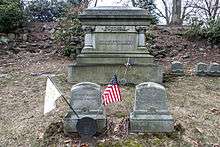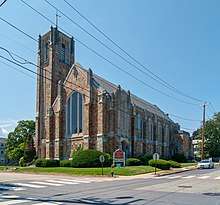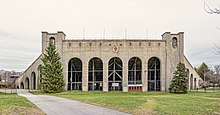Blackstone, Providence, Rhode Island
Blackstone is a predominantly residential neighborhood in Providence, Rhode Island. It is in the northeast corner of the city and is bounded to the south and west by Lloyd Avenue and Hope Street respectively. It is one of six neighborhoods comprising the East Side of Providence.
History



Blackstone is one of the last parts of Providence to be developed, as the remoteness of its location and marshy land had precluded significant development before the late 19th century. It wasn't until construction of Blackstone Boulevard in 1894 as a means of reaching Swan Point Cemetery that the area saw extensive residential development.
The area was largely marshland, and the earliest road was Cat Swamp Lane followed the high ground. Several farms were located in the area during the 1700s, and a few farmhouses from that era remain. [2] In the late 1700s, several burial grounds were established in the remote western part of the city. Several of these by 1847 and 1858 became consolidated into present-day Swan Point Cemetery.[3]
Construction of Blackstone Boulevard
By the 1870s the cemetery was accessible by means of a public omnibus which journeyed by means of a winding zigzag road which ran along present-day North Main Street, Olney Street, Morris Avenue, Sessions Street, Cole Avenue, and Rochambeau.[3] In 1886 the directors of Swan Point Cemetery hired landscape architect Horace Cleveland of Chicago to plan a road to improve access to the cemetery from the town of Providence. This road opened in 1894 as Blackstone Boulevard.[3]
Blackstone Boulevard became a catalyst for development in the neighborhood, spurring construction of single family homes which were "architecturally distinctive" from the rest of the city.[2] Between 1890 and 1923, property values along the Boulevard tripled, as the neighborhood became one of the most desirable and fashionable in the city.[2]
The 20th century saw institutional development in the form of Central Baptist Church, Temple Emanuel, and St. Sebastian's Roman Catholic Church.
Description
The Blackstone neighborhood comprises the northeast corner of the East Side of Providence, between the eastern ridge of the Moshassuck River Valley and the western bank of the Seekonk River.[2] Blackstone is primarily residential, and made up of mainly of single-family dwellings. It is one of the city’s most affluent neighborhoods.[2]
Houses of Worship
Notable religious institutions in the area include Temple Emanu-El, St. Sebastian’s Roman Catholic Church and the Community Church of Providence (formerly Central Baptist).
The Community Church began as an offshoot of the First Baptist Church in America.[4] The congregation originally was known as the Second Baptist Church, then Pine Street Baptist, and in 1917 opened at Lloyd and Wayland Street as Central Baptist.[4] In 2003, the church became known as Community Church of Providence. Between 1917 and 2018 the building featured a large Tiffany stained glass memorial to Frederick W. Hartwell created by Agnes Northrop titled "Light in Heaven and Earth."[4] The complex work was considered "one of the largest and finest landscape windows ever produced by Tiffany Studios," but largely overlooked in the community.[4] In 2018, the church sold the window to the Art Institute of Chicago where it is undergoing conservation and preparation to be displayed prominently in September 2020 as the Hartwell Memorial Window.[4]
Brown University
Brown University built several facilities in the neighborhood. Ladd Observatory was built in 1891 on the edge of the neighborhood at Hope Street and Doyle Avenue. In the 1920s Brown built several athletic facilities along Elmgrove Avenue, including Brown Stadium (1925), Aldrich Field (1925—1961),[5] and Marvel Gymnasium (1927—1989).[6] Aldrich field was sold in 1961 and developed as a residential neighborhood, with streets named for Brown presidents Maxcy, Faunce, Barbour, and Wriston.[5] Marvel Gym was closed in 1989 and demolished.[6]
Hospitals

Butler Hospital, located off Blackstone Boulevard, is Rhode Island's only private mental health hospital. Founded in 1844, the hospital offers psychiatric and substance-abuse treatment programs.[7] The hospital was built in 1847 on the Richard Browne Farm at the end of Rochambeau Avenue.[2] The building is a huge Gothic structure surrounded by landscaping, built according to the philosophy of the time to remove patients from the stresses of urban life to a rural setting.[2]
Parks
- Blackstone Boulevard Park[8] is a green space between northbound and southbound lanes of Blackstone Boulevard. It consists of 19.3 acres (78,000 m2) of parkland and a 1.7-mile (2.7 km) jogging/walking path.[8]
- Lippitt Memorial Park is located at the intersection of Hope Street and Blackstone Boulevard near the Pawtucket border.[9]
Demographics
According to the Providence Plan,a local nonprofit aimed at improving city life, 92.5% of residents are white, well above the citywide average of 54.5%.[10]
Blackstone is one of the most affluent neighborhoods in the city with a median family income nearly four times that of the city and housing values more than doubling in recent years. The median household income is $87,727, and the median family income is $117,522. Only 1.1% of families live below the poverty line.[10]
The neighborhood is home to a significant Jewish population. The Jewish Community Center of Rhode Island was established on Elmgrove Avenue in 1971; later this merged with other communal organizations and became known as the Jewish Alliance of Rhode Island.[11] The area is also home to the Providence Hebrew Day School on Elmgrove Avenue and Temple Emmanuel on Morris Avenue.
Government
Ward Two encompasses Blackstone, all of College Hill and Wayland north of Angell Street, and parts of Mount Hope.[12] As of the 2018 elections, Helen Anthony, a Democrat, represents the ward in the City Council.[13]
References
- "Our Story & Home". Community Church of Providence. Retrieved 13 July 2018.
it also changed its name twice: first to Pine Street Baptist Church, then to Central Baptist
- Deller, Thomas E. (2009). Providence Tomorrow: Mt. Hope, Hope, and Blackstone Neighborhood Plan (PDF). Providence Department of Planning and Development. p. 9-10. Retrieved 23 February 2020.
- "Swan Point Cemetery Founding & Early Years". Swan Point Cemetery. Providence, Rhode Island. Archived from the original on 13 April 2019. Retrieved 13 April 2019.
- Naylor, Donita (21 February 2020). "Tiffany church window, unnoticed in Providence, will be a star attraction in Chicago art museum". The Providence Journal. Archived from the original on 23 February 2020. Retrieved 23 February 2020.
- Mitchell, Martha (1993). Encyclopedia Brunoniana. Brown University Library. Retrieved 13 April 2019.
- Mitchell, Martha (1993). Encyclopedia Brunoniana. Brown University Library. Retrieved 13 April 2019.
- Butler Hospital, Providence Rhode Island : About Butler Hospital
- Citywide Green
- Google Maps
- Blackstone Archived 2007-09-28 at the Wayback Machine
- "History". Jewish Alliance of Greater Rhode Island. Retrieved 13 April 2019.
- ward2.jpg Archived 2006-11-15 at Archive.today
- "Providence City Council". Archived from the original on 2019-02-13. Retrieved 2019-02-13.
| Wikimedia Commons has media related to Blackstone, Providence, Rhode Island. |
